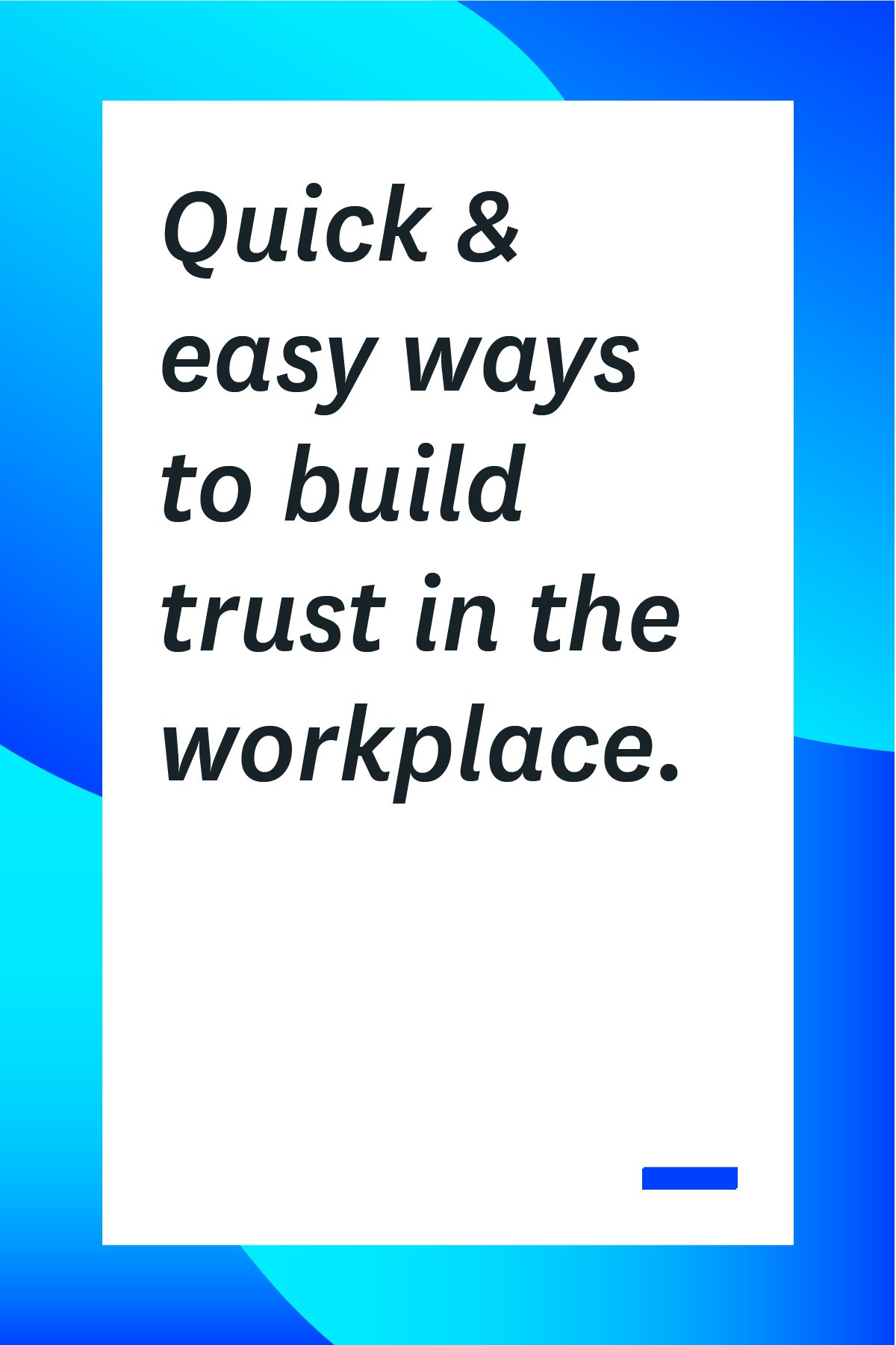
9 Tips for Building Trust in the Workplace | Engage Blog
9 Tips for Building Trust in the Workplace
Kellie Wong
September 22, 2020
If you’d like your organization to succeed, you must foster mutual trust between all team members. But this is easier said than done. Only 1 out of 5 HR and engagement leaders believe their employees deeply trust company leaders, and 50 percent of employees said they don’t think HR is trustworthy.
Trust is essential for in-person teams and remote workers. Without it, any employee is likely to be less motivated and productive. In fact, workers at high-trust companies report 74 percent less stress, exhibit 50 percent higher productivity, and experience 40 percent less burnout.
Below, we’ll dive deeper into why trust in the workplace matters, as well as nine ways you can build trust among your employees.
Why does trust in the workplace matter?
Trust in the workplace means your employees enjoy a culture of honesty, psychological safety, and mutual respect. They’re proud of where they work and are more willing to go above and beyond for your organization. Trust in the workplace also helps employees feel secure in their jobs and, in turn, reduces turnover.
Although you may have a long to-do list, building and maintaining employee trust should be at the very top. If you put it on the back burner, you’re likely to notice a decline in productivity and employee satisfaction. Fortunately, more and more organizations are realizing the importance of workplace trust. Ninety-six percent of CEOs rate building and maintaining trust with employees a high priority, and 42 percent have increased the importance they place on building trust in the past five years.
Start building trust with your teams today by accessing this free webinar.
Trust does more than encourage employees to get their work done. It builds employee engagement, which often leads to higher quality work and better results for your company. It’s no surprise that 80 percent of HR professionals link engagement to trust in leaders and 55 percent of business leaders believe a lack of trust in the workplace constitutes a foundational threat to their company.
By prioritizing workplace trust, you can also build a diverse and inclusive culture where your employees will feel a sense of belonging and be more connected to their team.
And trust helps create an environment of psychological safety where your team members will feel comfortable asking questions, sharing ideas, and expressing their thoughts.
"There's so much that goes into a great employee experience--most notably trust--and employees aren't getting it from their employers. [...] Employees are craving genuine workplace relationships where they feel safe, valued, and their manager has faith in their ability to get the job done." - Deb Muller, CEO, HR Acuity
Muller makes it clear that in today’s world, building trust in the workplace is must-have, not a nice-to-have. If you focus on it, you can create an employee experience that aligns well with the priorities and motivations of your workforce — one that encourages them to stay at your organization and perform their very best work.
How to build trust in the workplace
Here are nine of the best strategies for fostering an environment of trust in the workplace.
1. Listen more than you speak
Your employees are unique individuals who have their own ideas and viewpoints. Ask them to speak their mind, and when they do, genuinely listen. This is the foundation for positive workplace relationships built on mutual understanding and trust.
To improve your listening skills, it’s a good idea to engage in active listening training. This involves making a deliberate effort to ask your employees questions and encourage them to elaborate more so you can truly understand what they’re trying to communicate. There are opportunities to listen every day. For instance, set aside some time in meetings for employees to discuss their work experience and how they’re feeling. Remember that you should be ready to listen to both positive and negative feedback, and that you need to demonstrate you’re open to their feedback whether you agree with it or not.
Discover how listening to your team can improve everyone’s quality of life.
2. Solicit and act on feedback
HR professionals and managers can’t be everywhere they need to be to hear all the valuable feedback employees have. But employees want a voice in their organization, and it’s hard to make the case that they should trust you if you’re not willing to do what it takes to capture their feedback and take prompt action on it. Brad Killinger, CEO of Sapience Analytics, notes that an “employee feedback framework is critical so if an employee struggles, management can bring the proper training, resources and support to their aid.”
You need to solicit feedback on a continuous basis: only 10 percent of employees are satisfied with yearly requests for feedback, while 64 percent want a way to provide feedback at any time. Look for a feedback solution that incorporates pulse surveys so you can frequently gather input from team members and open an always-on, employee-driven feedback channel like a workplace chatbot so your employees can share their thoughts at any time. You should also look for a tool supported by a team of feedback experts that can work with you to identify your specific needs and then build a customized survey cadence and list of questions that will give you insightful responses you can act on.
Once you gather feedback via surveys and employee check-ins, analyze the results to identify hotspots that show where your team is strong and where there are areas for improvement. You can then act quickly to shore up weak areas before they become serious problems. Be sure to communicate the results to your team promptly and work with them to determine what actions you can take to improve their experience in the workplace. Building a collaborative action plan demonstrates transparency and helps employees feel valued. The entire feedback process shows that you trust employees intimately, and they’ll repay you in kind.
Perhaps most importantly, follow through with your action plan in a timely fashion. When employees see the tangible effects of their feedback, their trust in the organization will grow. If you don’t respond quickly, employees will quickly grow dissatisfied and feel that their feedback doesn’t matter. But when leaders show prompt responsiveness, it communicates trust, respect, and empathy to employees.
Bayhealth, Delaware’s largest not-for-profit healthcare system, saw the benefits of timely action when it implemented an always-on feedback channel so its front-line leaders could receive real-time feedback about day-to-day issues that required immediate attention — a critical concern in a patient caring workforce. Leaders began to see employee feedback shared by patient caregivers regarding an incredibly difficult patient who made them feel unsafe, causing extreme stress, anxiety and unhappiness. To address the feedback, leaders set up de-escalation training to help employees understand signs of patient anxiety, and to guide them in how best to handle these sensitive situations. Instead of being left to face this situation by themselves, Bayhealth’s employees learned to trust that leadership listened to their concerns and had their backs.
3. Show appreciation every day
Yes, your employees get a paycheck in return for their work, but this isn’t enough to demonstrate that you value and trust them. It’s vital to provide them with frequent recognition in real time. You may show recognition by sending thank you messages, offering verbal praise, and distributing tangible rewards like bonuses and employee awards.
Everyday appreciation builds a sense of community and helps employees feel emotionally secure, so when you recognize your team often, they’ll be more likely to trust you. Approximately 90 percent of employees who receive thanks or recognition from their boss report feeling high levels of trust in that individual. This figure went down to 48 percent for workers who did not receive recognition. So if you want to foster trust in your workplace, lean into the direct relationship between trust and recognition.
Remember that public recognition is just as important as recognizing employees privately — if not more so. You can highlight your employees’ accomplishments during team meetings, in a hall of fame, or via a company-wide newsfeed. Let others within your organization know that your workers are doing a great job — preferably with a recognition platform that makes recognizing employees from anywhere across channels a snap.
4. Empower your team by trusting them first
If you take the first step and show your employees that you trust them, they’ll be more likely to trust you back. So how can you make it clear that you trust your workers? Empower them by encouraging professional development and autonomy. Add extra responsibilities on their plate. Invite them to sit in on meetings that they typically wouldn't attend. For instance, let a sales rep sit in on a strategy meeting so they can provide their on-the-ground insights to help guide your sales and marketing plans going forward. They’ll remember the trust you showed in them, and you’ll benefit from their unique perspective.
When you closely observe or micromanage your team’s work, your workers are bound to feel like you don’t trust them. Most employees don’t want you to look over their shoulders. They want to feel trusted enough to be able to work with minimal supervision. Macromanaging instead of micromanaging demonstrates that you trust your employees and believe in their knowledge and experience. Be supportive without hovering, and show that you’re available without putting pressure on them, so your employees know you trust them to act on their own but are always there if they need to reach out.
Empower your employees and see their engagement skyrocket — find out why.
5. Encourage coaching
Managers and leaders play a vital role in building trust in the workplace. Research has shown that authentic leadership can cultivate trust and improve employee engagement and performance. One of the most effective ways for them to do this by coaching their employees rather than acting like traditional “bosses” and disciplining employees after they do a poor job. If you coach your employees and meet their expectations, they’ll be more likely to trust you and listen to your advice.
When you coach employees, you provide them with more training, support, and encouragement, especially when they’re struggling. While most millennials look to their manager as their primary source for learning and development, only 46 percent believe they fill this role. Act as a cheerleader and guide your employees to success, rather than just managing them, and you’ll realize a huge range of benefits, from a 22 percent increase in profitability to improved work relationships among up to 77 percent of your organization.
6. Practice consistency
Following up your words with actions every so often will not build trust. You need to prove that you’re consistent. Practice what you preach, day in and day out, so your team knows what to expect and won’t have to wonder if you’re going to deliver. If you demand your team shows up on time, do the same. If you expect them to know your clients inside and out, do your homework as well. Your employees will trust that you’ll keep your word, lead by example, and do a great job.
In addition to being consistent with your performance, ensure consistency in your mood. Do your best to stay calm, cool, and collected, even in uncomfortable or difficult situations. An inconsistent mood may instill nervousness and anxiety in employees, and it can make it difficult for them to trust you.
7. Focus on nonverbal communication and soft skills
While verbal communication is important, it’s not everything. Nonverbal communication and soft skills, like personality traits, attitudes, and behaviors are just as crucial. If you make eye contact with your employees and nod when they speak rather than check your email or look at the clock, you’ll demonstrate your interest in what they have to say. Positive body language paired with skills like empathy, patience, and problem solving create a welcoming atmosphere for employees and encourages them to approach you. Most importantly, always be genuine and authentic when communicating. If employees don’t think you’re speaking from the heart, any trust in you will evaporate. The more comfortable your team feels around you, the more likely they are to trust you.
Find out how to develop soft skills in the modern workplace.
8. Create an inclusive culture
Your company culture is the collection of traits that define your company. While a great culture will likely lead to strong performance, a dysfunctional one can keep you from meeting your organizational goals. Even though your culture will be unique, it should reflect qualities like appreciation, resilience, and teamwork. And of course, developing a culture that everyone at your workplace buys into is a key part of establishing trust in your organization.
That’s why it’s important to build an inclusive culture — one that accepts and values the strengths of all your employees. According to Gartner, inclusive and diverse teams can see performance improvements of up to 30 percent. Pursue initiatives that focus on equal pay and benefits, workplace accessibility, and diversity education and training to start creating a culture that welcomes everyone.
Another way to foster diversity is through employee networks — groups of employees that voluntarily come together based on a common life experience or identity. Also known as employee affinity groups or employee resource groups, they offer mutual support, improve personal and professional development, and bring employees together. As Jeff Cates, CEO and President of Achievers, notes, an employee network “gives every employee the opportunity to connect with their teammates outside of work around topics and issues that are important to them and gives a voice to specific groups.” Achievers has created several employee networks — from the Achievers Women’s Network to the charity-focused Achievers CARES network to Achievers Proud for the LGBTQ+ community and its allies — that help build trust and community in the workplace. In addition, Achievers has a D&I steering committee that acts as the primary advocate for all things D&I, with a mission to drive D&I initiatives to success.
9. Be honest and transparent
There’s no denying that telling the truth can be tough. It’s often easier to tell your employees what they want to hear — especially during difficult times. By being honest with your employees while being sensitive to their feelings, however, you can encourage them to trust you.
If you’re not honest with a member of your team, you may lose more than their trust and respect, however. Every relationship, whether professional or personal, is based on honesty. One lie can ruin even a long-term relationship — potentially irreparably.
You should also be transparent when it comes to discussing changes to business processes and updates so that your employees are always in the know. Your team won’t trust you if you catch them by surprise by modifying a procedure without making it known or neglect to inform them in advance regarding major changes in the workplace.
When being honest and communicating with your employees, engage them. Make it clear that you care about their feelings and want to hear their input. They won’t feel valued if you tell them something and close without giving them the opportunity to speak. A two-way conversation makes it clear that you’re not there to talk at them — you’re there to talk with them.
HR professionals have a special duty to communicate with employees directly and transparently. Their insight into the organization and its employees puts them in a unique position to shape the messages and model the behaviors that keep employees informed and engaged. HR should work to connect leadership with employees and address the concerns of each to foster lasting relationships built on trust.
Learn why communication is the key to creating a sense of connection and belonging in the workplace.
Start building trust with your employees
Two of the most effective ways to strengthen trust with your workforce is through taking immediate action on employee feedback and offering words of appreciation on a daily basis. There are few things that will mean more to employees than seeing issues that are important to them acted upon or seeing their hard work recognized.
That’s where Achievers Listen and Achievers Recognize come in. Achievers Listen is an employee engagement solution that makes it a breeze to collect feedback from employees via pulse surveys. It also comes with an always-on engagement channel that facilitates regular employee check-ins and an Action Builder for you to identify hotspots and refine insights for easier collaborative action planning with your team. It provides the insights HR teams and people leaders need to connect with their people, make data-driven decisions, and work with their teams on action plans whose success everyone is invested in — all of which are great pillars to build trust on.
Achievers Recognize enables every employee to easily send and receive points-based and social recognition to another. Recognition can be delivered across channels and amplified using a company-wide newsfeed, and employees can like and comment on them using an intuitive, fun user interface. Your employees can redeem points for rewards they actually value. Celebrating everyday wins — both big and small — is an excellent way to create a supportive culture where everyone is invested in each other’s success.
Intrigued? Try a free demo of Achievers Listen and Achievers Recognize today!
What is Achievers?
SHARE THIS
About Kellie Wong
Kellie Wong is a Senior Content Marketing Manager at Achievers. She manages Achievers' Engage blog, produces a wide range of marketing content, and focuses on SEO. In addition to being the final editor of all blog content for Engage, she also manages relationships with 45+ writing contributors. Connect with Kellie on LinkedIn.
Achievers’ employee voice and recognition solutions bring your organization’s values and strategy to life. Activate employee participation and fuel a culture of performance to experience data-driven business results. To learn more, visit www.achievers.com.










